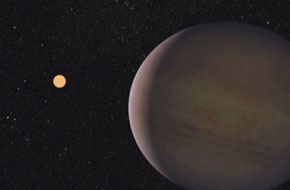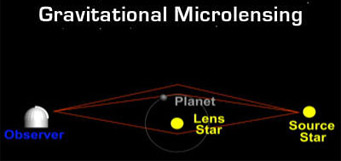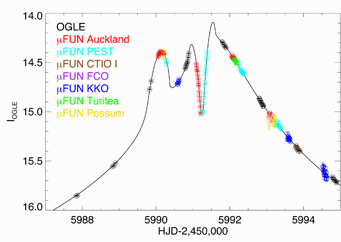Amateur astronomers perform a crucial role in detecting exoplanets by a technique called microlensing, including the most recent discovery of a multiple-planet system.

Microlensing is ideal for finding planets orbiting outside the snow line. This artist's concept shows the first planet discovered via microlensing, a Jupiter-mass planet orbiting a red dwarf star at least 10,000 light-years away from the Sun.
Earlier this month the Kepler mission announced yet another bevy of new exoplanet candidates, their list now stretching 2,740 candidates long. But Kepler’s not the only planet-hunter on the scene. A less splashy study reported in January 10th’s Astrophysical Journal heralded the second multiple-planet system discovered by microlensing, a technique that makes good use of amateur astronomers’ skills and dedicated telescope time.
To find a planet by microlensing, planet-hunters closely monitor millions of stars in the Milky Way’s busy bulge. When a foreground object, usually a star, passes between, it acts as a lens, momentarily magnifying the light from the background star. If the lens is a simple foreground star, the background star brightens and fades in a characteristic pattern, but a planet orbiting the foreground star will add a secondary spike. Only amateurs can dedicate near-continuous coverage to capture the light curve’s details.

An illustration of gravitational microlensing, where a passing foreground star acts as a lens, magnifying a background star's light. A planet orbiting the foreground star will add a bump to the light curve.
NASA
The skeptical reader might wonder why we need any other planet-hunting techniques when Kepler does the job so well. But Kepler can’t do everything. Even as it edges down to find the smallest, Earth-like planets, Kepler still has a hard time finding planets beyond the snow line, the point in a forming planetary system where water ice could have condensed. Gas giants are thought to form beyond the snow line (even though they might later migrate closer to the star) — and these beyond-snow-line planets are exactly those astronomers need to pin down theories of planet formation.
Nor can Kepler find planets beyond the Sun’s local neighborhood — the very furthest Kepler can see is about 3,000 light-years away. Microlensing, on the other hand, could find planets as far as the galactic center, 26,000 light-years away.
Finding a single microlensing event requires monitoring millions of stars, a job for survey scopes such as the New Zealand–based Microlensing Observations in Astrophysics (MOA) or the Optical Gravitational Lensing Experiment (OGLE), a Polish project using the Las Campanas Observatory in Chile. But following interesting events becomes too time-intensive for professional scopes, and that’s where the amateurs come in.
The microFUN collaboration, founded in 2004, consists of 23 observatories, 16 of them amateur-run. When a survey scope pinpoints a promising microlensing event, the other observatories follow up, filling in the light curve.
“These high-magnification events get really bright,” says Jennifer Yee (Ohio State University), a graduate student member of microFUN. “That works well for our network because these telescopes are typically smaller, maybe a half-meter in size.”
Despite their relative brightness, the observations are challenging, and take skill and dedication to obtain. “Even a bright lens will in most cases only reach a peak brightness of around magnitude 15 in the near-infrared,” says Berto Monard, an amateur member of microFUN since 2006. “This is a faint, sometimes near-invisible, dot or smudge amidst a star region with thousands of brighter stars, on a CCD chip that shows a star field one-third the size of a full Moon.”

After OGLE caught a star brightening quickly, the Microlensing Follow-Up Network (MicroFUN) issue an alert urging immediate observations. The resulting coverage by amateur observatories around the world caught the details, showing two planets orbiting a star 13,000 light-years away.
OGLE / The microFUN collaboration
Last March, six microFUN observatories around the world followed the event called OGLE-2012-BLG-0026 to provide near-continuous coverage over several nights, and uncovering humps and dips in an otherwise normal rise-and-fall microlensing event.
When Cheongho Han (Chungbuk National University, Korea) and his collaborators modeled the microFUN light curve, they discovered a Neptune-like planet and a Jupiter-like planet orbiting the Sun-like (G-type) host — and both planets orbit beyond the snow line. The event took long enough that the Earth’s motion around the Sun affected the light curve; the resulting parallax allowed Han and his colleagues to estimate that the two-planet system lies 13,000 light-years away, about halfway to the galaxy’s center.
Of the 18 planets discovered via microlensing, OGLE-2012-BLG-0026 is the second multiple-planet system where both planets are gas giants orbiting beyond the snow line. The population detected so far is too small to draw any firm conclusions about planetary formation, but maybe exoplanet systems like ours — with gas giants that form beyond the snow line and stay there — aren’t so rare after all..
Despite, or perhaps because of, Kepler’s success, the microlensing hunt for exoplanets won’t go away anytime soon. Want to "join the fun?" Visit microFUN’s website to learn more about what you need to get started.
“Our whole network is about involving amateurs,” says Jennifer Yee (Ohio State University). “We’re always happy to have new people.”
 0
0
Comments
You must be logged in to post a comment.